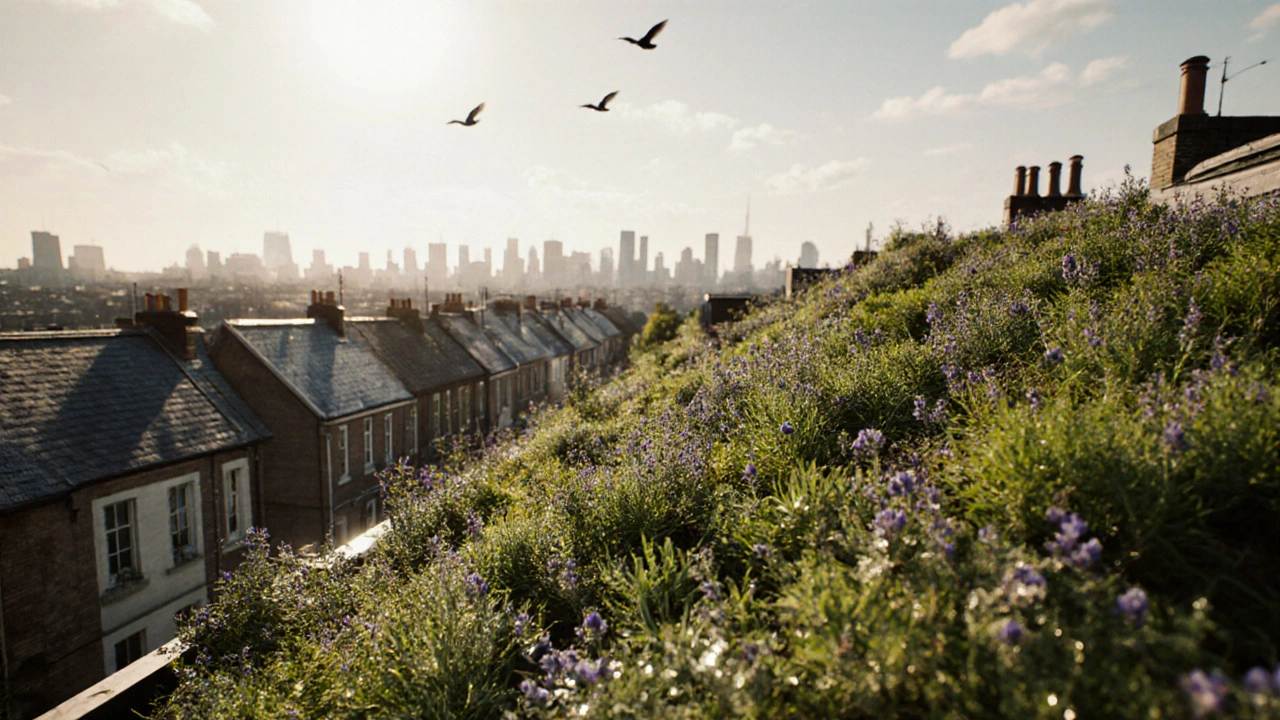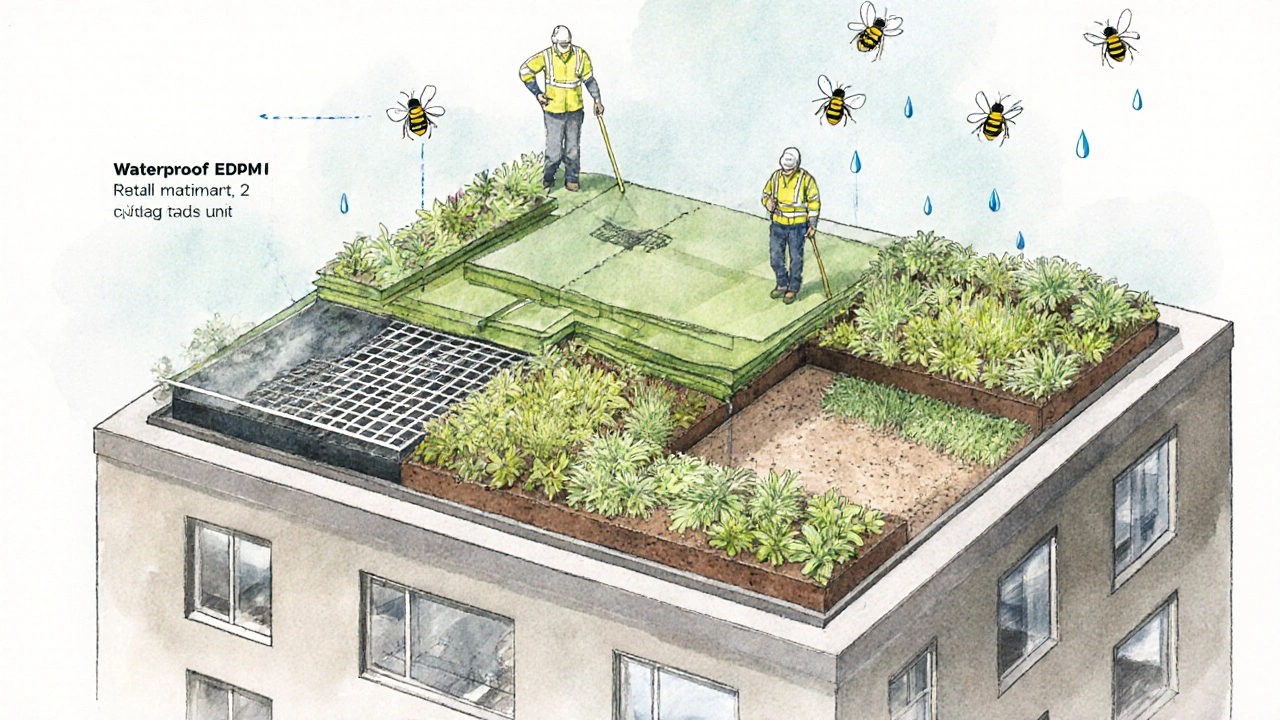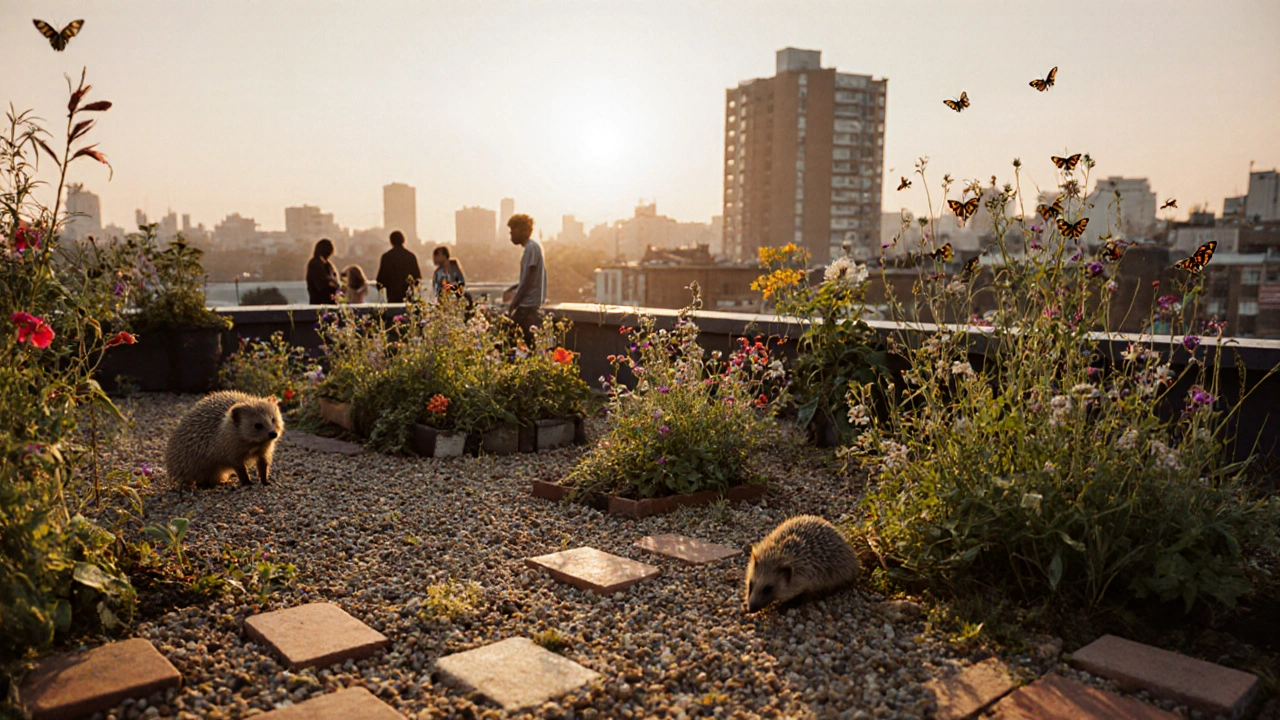
London’s skyline is changing-not with more glass and steel, but with plants. Across the city, rooftops once covered in tar and gravel are now bursting with sedum, grasses, and wildflowers. These aren’t just pretty views from above. Green roofs are turning concrete jungles into living ecosystems that cool buildings, cut pollution, and bring nature back to the city. If you’re thinking about installing one, here’s what you actually need to know-no fluff, no marketing buzzwords, just the real steps and costs.
Why London Needs Green Roofs
London heats up faster than most UK cities. In summer, rooftop temperatures can hit 60°C. That’s not just uncomfortable-it spikes energy bills and worsens air quality. Green roofs lower surface temps by up to 30°C. They also soak up rainwater. A single square meter of green roof can hold 40-70 liters during a storm, reducing pressure on sewers that overflow during heavy rain.
It’s not just about climate. A 2024 study by Imperial College London found that buildings with green roofs had 20% fewer asthma-related hospital visits nearby. Birds, bees, and beetles are returning to rooftops where they vanished decades ago. These aren’t decorative add-ons. They’re functional infrastructure.
Types of Green Roofs You Can Install
Not all green roofs are the same. There are three main types, each with different needs and costs.
- Extensive green roofs are the most common in London. They use shallow soil (5-15 cm) and hardy plants like sedum, moss, and wild thyme. They weigh 50-150 kg per square meter when wet and need almost no maintenance. Perfect for flat or slightly sloped roofs.
- Intensive green roofs are like rooftop gardens. Think lawns, shrubs, even small trees. They need deep soil (30 cm or more), regular watering, and someone to mow or prune. They weigh 150-500 kg per square meter. Only suitable for strong, reinforced structures.
- Biodiverse roofs are designed to mimic natural habitats. They use recycled bricks, gravel, and native plants to attract insects and birds. No irrigation. Minimal upkeep. Often used on industrial buildings or as part of council-led projects.
Most homes and small businesses in London go with extensive roofs. They’re affordable, lightweight, and fit most existing structures.
Step-by-Step: How to Install a Green Roof
Installing a green roof isn’t like putting up a shed. You’re adding a whole new layer to your building. Here’s how to do it right.
- Check your roof’s structure. Older buildings, especially Victorian terraces, weren’t built for extra weight. Hire a structural engineer to confirm your roof can handle 50-150 kg/m². If it can’t, you’ll need reinforcement-this adds £1,000-£5,000 to the cost.
- Install a waterproof membrane. This is non-negotiable. Use a root-resistant, waterproof layer like EPDM or PVC. If water gets in, you’re dealing with rot, mold, and structural damage. This step alone costs £15-£30 per square meter.
- Add a drainage layer. This is usually a plastic grid or geotextile mat that lets excess water flow away without washing soil out. It also protects the membrane from roots.
- Layer in growing medium. Use lightweight, engineered soil mix-not garden soil. It drains fast and doesn’t compact. For extensive roofs, 8-12 cm is enough. Spread it evenly.
- Plant or lay pre-grown mats. You can either plant individual sedum plugs (cheaper but slower) or lay ready-made vegetation mats (faster, more expensive). Mats cost £25-£40 per m²; plugs cost £10-£15 per m² but take 1-2 years to fully cover.
- Install edging and access points. Edge strips keep soil from washing off. Include a small access path if you plan to do maintenance. Don’t forget a rainwater overflow outlet.
For a 20m² roof, expect to pay £2,000-£4,500 installed. DIY is possible, but only if you’re comfortable working on roofs and have help lifting heavy materials.

What It Costs to Maintain a Green Roof
Green roofs aren’t “set and forget.” But they’re far easier than you think.
- Extensive roofs: Check twice a year-in spring and autumn. Remove weeds (especially bindweed or ivy), clear debris from drains, and inspect the membrane edges. That’s it. Annual cost: £50-£150.
- Intensive roofs: Treat them like a garden. Water during dry spells (May-August), fertilize lightly in spring, trim plants, and clear leaves. Annual cost: £300-£800.
- Biodiverse roofs: Leave them alone. Once established, they need almost nothing. Maybe check drains once a year.
One common mistake: people assume green roofs need watering year-round. They don’t. Once established (after 12-18 months), most sedum and native plants survive London’s rain. Only water if there’s been no rain for 6+ weeks.
What You Can’t Do
There are limits. Don’t install a green roof if:
- Your roof slopes more than 30°-plants will slide off.
- Your roof is leaking or damaged-fix it first.
- You’re on a listed building without permission-Historic England requires approval.
- Your building has asbestos roofing-removal adds huge cost and risk.
Also, avoid planting vegetables or fruit trees unless you’re installing an intensive roof. Most green roofs aren’t designed for heavy root systems or frequent digging.

London-Specific Tips
London’s weather is wet but not always warm. Choose plants that thrive in cool, damp conditions:
- Sedum acre and Sedum kamtschaticum-survive frost and drought.
- Thymus serpyllum (wild thyme)-low, fragrant, attracts bees.
- Campanula portenschlagiana-purple bell flowers, great for edges.
- Brachyglottis repanda-evergreen shrub, tolerates pollution.
Also, consider wind. Tall buildings get strong gusts. Use heavier mats or anchor plants with small stones. Avoid tall grasses-they’ll snap.
Many London councils offer grants. Camden, Islington, and Tower Hamlets give up to £1,500 for residential green roofs. Check your borough’s sustainability page-some even provide free design advice.
Real Results: What’s Working in London
At the Brixton Recreation Centre, a 300m² green roof cut summer cooling costs by 35%. The roof also reduced noise levels inside by 10 decibels.
At a housing co-op in Peckham, residents turned a flat roof into a shared garden with herbs and pollinator plants. They now host monthly gardening sessions. Crime reports in the building dropped 18% in two years-community space matters.
Even small projects count. A terraced house in Hackney installed a 12m² sedum roof. The homeowner saw their roof lifespan double-from 15 to 30 years-because the membrane was protected from UV and temperature swings.
Next Steps: What to Do Now
If you’re serious:
- Get a structural survey-costs £200-£400.
- Check your borough’s green roof grant program.
- Visit the London Wildlife Trust rooftop garden in Camden-it’s open to the public.
- Order samples of sedum mats from suppliers like Green Roof Systems UK or Vegetal Green Roofs.
- Start small. A 5m² test patch lets you see how your roof reacts before going all in.
Green roofs aren’t magic. But they’re one of the few urban fixes that actually work-cooling air, cleaning water, bringing back wildlife, and making buildings last longer. In London, where space is tight and climate pressure is rising, turning unused roofs into habitats isn’t just nice. It’s necessary.
Can I install a green roof on my flat roof house in London?
Yes, if your roof is structurally sound and slopes less than 30°. Most London homes with flat or low-slope roofs can support an extensive green roof. Get a structural survey first-older homes may need reinforcement. Extensive roofs weigh only 50-150 kg per m² when wet, which most modern roofs can handle.
Do green roofs attract pests like rats or birds?
They don’t attract rats. Rats look for food scraps and shelter in bins or drains-not in well-drained, planted roofs. Birds and insects, however, are welcome. Green roofs are designed to support biodiversity. Bees, butterflies, and even hedgehogs have been spotted on London rooftops. If you’re worried about birds nesting, use mesh netting during planting season.
How long does a green roof last?
A properly installed green roof can last 40-50 years. The plants and soil have a lifespan of 20-30 years, but the waterproof membrane underneath can last 50+ years. In fact, green roofs protect the membrane from UV rays and extreme temperatures, often doubling the life of your roof compared to a traditional one.
Are green roofs expensive to maintain?
Extensive green roofs cost as little as £50-£150 per year-just two quick checks and some weeding. Intensive roofs are more like a garden, costing £300-£800 annually. Most London homeowners find the cost low, especially since green roofs reduce energy bills and extend roof life. Many councils even offer grants to offset initial costs.
Can I grow vegetables on a green roof?
Only on intensive green roofs with deep soil (30 cm+). Extensive roofs aren’t suitable-they’re too shallow and use lightweight soil that doesn’t hold nutrients well. If you want to grow food, plan for a dedicated raised bed section with proper drainage and fertilization. Don’t try to turn a sedum roof into a vegetable patch.
Do I need planning permission for a green roof in London?
Usually not for residential properties if you’re replacing a flat roof with a similar profile. But if you’re adding height, changing the building’s appearance, or live in a conservation area or listed building, you’ll need permission. Always check with your local council’s planning department. Some boroughs encourage green roofs and have fast-track approvals.